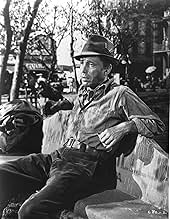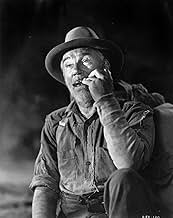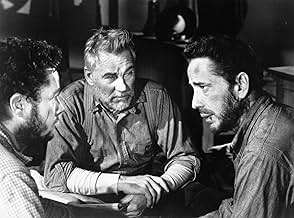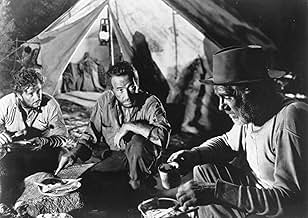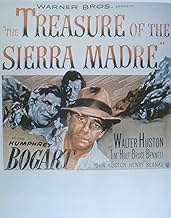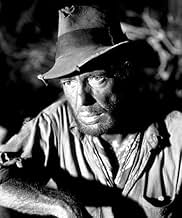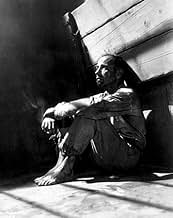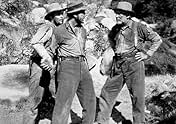Messico. Fred, senza soldi e senza lavoro conosce un vecchio cercatore d'oro e, affascinato dai suoi racconti, lo convince a partire per la Sierra Madre. A loro si unisce un altro giovane co... Leggi tuttoMessico. Fred, senza soldi e senza lavoro conosce un vecchio cercatore d'oro e, affascinato dai suoi racconti, lo convince a partire per la Sierra Madre. A loro si unisce un altro giovane compagno. I tre riescono a trovare l'oro; ma l'avidità li renderà spietati.Messico. Fred, senza soldi e senza lavoro conosce un vecchio cercatore d'oro e, affascinato dai suoi racconti, lo convince a partire per la Sierra Madre. A loro si unisce un altro giovane compagno. I tre riescono a trovare l'oro; ma l'avidità li renderà spietati.
- Regia
- Sceneggiatura
- Star
- Vincitore di 3 Oscar
- 18 vittorie e 5 candidature totali
Barton MacLane
- Pat McCormick
- (as Barton Mac Lane)
Arturo Soto Rangel
- Presidente
- (as A. Soto Rangel)
Manuel Dondé
- El Jefe
- (as Manuel Donde)
José Torvay
- Pablo
- (as Jose Torvay)
Robert Blake
- Mexican Boy Selling Lottery Tickets
- (non citato nei titoli originali)
Guillermo Calles
- Mexican Storeowner
- (non citato nei titoli originali)
Roberto Cañedo
- Mexican Lieutenant
- (non citato nei titoli originali)
Spencer Chan
- Proprietor
- (non citato nei titoli originali)
Jacqueline Dalya
- Flashy Girl
- (non citato nei titoli originali)
Ralph Dunn
- Flophouse Bum
- (non citato nei titoli originali)
Ernesto Escoto
- Mexican Bandit
- (non citato nei titoli originali)
Pat Flaherty
- Customer in Bar Who Warns Curtin and Dobbs about Pat McCormick
- (non citato nei titoli originali)
Riepilogo
Reviewers say 'The Treasure of the Sierra Madre' is a critically acclaimed classic, lauded for its profound examination of greed, betrayal, and human nature. John Huston's direction and screenplay, alongside exceptional performances by Humphrey Bogart, Walter Huston, and Tim Holt, are often celebrated. The film's authentic atmosphere, intricate character studies, and moral complexities deeply resonate. Although some critique its pacing and subplots, most regard it as a timeless masterpiece noted for its psychological depth and thematic richness.
Recensioni in evidenza
Magnificent rendition of B. Traven's story of ambition and human nature at its worst and dealing with an unlikely trio of ambitious prospectors . As Fred Dobbs (Humphrey Bogart) and Bob Curtin (Tim Holt) , two Americans searching for work in Mexico, convince an old prospector (Walter Huston) to help them mine for gold in the Sierra Madre Mountains . Through a lot of troubles they eventually succeed in finding gold, but greedy outlaws (Alfonso Bedoya) , and most especially craziness lead to disaster . As they sold their souls for the treasure of the Sierra Madre .
It's an intelligent semi-western that scrutinizes the greed and paranoia that afflicts a misfit group , including their enormous difficulties and breathtaking taking on between protagonists and the Mexican enemies that stalk to them . The film blends thrills , emotion , intrigue , high body-count and it's fast moving and exciting ; being filmed in Mexico, though Warners' studio head Jack L. Warner had the unit return to Hollywood when the budget started to exceed $3 million . Thought-provoking screenplay by the same Huston , concerning about greed and ambition that threaten to turn their success into disaster . Director John Huston had read the book by B. Traven in 1936 and had always thought the material would make a great movie . Based on a 19th-century ballad by a German poet , Traven's book reminded Huston of his own adventures in the Mexican cavalry . When Huston became a director at Warner Bros. , the smashing success of his initial effort, The Maltese Falcon (1941), gave him the clout to ask to write and direct the project, for which Warner Bros had previously secured the movie rights . Although by many to be director John Huston's finest film , this is a tale of fear , greed and murder , as three partners fall out over the gold they have clawed out of the inhospitable and bandit-ridden deserts and mountains . It also has probably the most brutal gold bar fight ever put on film along with "The Ruthless Four" . Overrated by some reviewers , but very interesting and attractive to watch . It above all things mostly also remains a real characters movie, in which the three main roles are the essentials . Their dynamic together is also great and is what mostly keeps this movie going . They are three totally different characters, which is the foremost reason why they work out so great together on film . Bogart is superbly believable and gives a nice portrait of an increasingly unhinged prospector , Walter Huston is very good as a cunning veteran and Tim Holt is also pretty well . John Huston has a cameo as an American tourist , this scene was directed by Humphrey Bogart, who took malicious pleasure on his director by making him perform the scene over and over again. And the little boy who sells Bogart the portion of the winning lottery ticket is Robert Blake . The bum seated near Walter Huston in the first scene in the Oso Negro flophouse is Jack Holt, father of Tim Holt . Walter Huston, father of director John Huston, won the Academy Award for best supporting actor , John won for best direction . This was the first father/son win .
The musician Max Steiner composes a vibrant soundtrack and well conducted ; including a catching leitmotif and considered to be one of the best . Atmospheric scenario with barren outdoors , dirty landscapes under sunny exteriors and a glimmer sun and fine sets with striking cinematography by Ted McCord , this was one of the first American films to be made almost entirely on location outside the USA . Also shown in computer-colored version . The picture was shot on location in Tampico, Mexico ; just as John Huston was starting to shoot scenes in, the production was shut down inexplicably by the local government ; it turns out that a local newspaper printed a false story that accused the filmmakers of making a production that was unflattering to Mexico . Fortunately, two of Huston's associates, Diego Rivera and Miguel Covarrubias, went to bat for the director with the President of Mexico , then the libelous accusations were dropped . The motion picture was stunningly realized by John Huston and the film took 5-1/2 months to shoot and was 29 days over schedule ; Robert Rossen submitted at least nine drafts of rewrites on the screenplay when John Huston was away during the war . Rating : Above average . Well worth watching , essential and indispensable seeing . In 2007: The American Film Institute ranked this as the #38 Greatest Movie of All Time.
It's an intelligent semi-western that scrutinizes the greed and paranoia that afflicts a misfit group , including their enormous difficulties and breathtaking taking on between protagonists and the Mexican enemies that stalk to them . The film blends thrills , emotion , intrigue , high body-count and it's fast moving and exciting ; being filmed in Mexico, though Warners' studio head Jack L. Warner had the unit return to Hollywood when the budget started to exceed $3 million . Thought-provoking screenplay by the same Huston , concerning about greed and ambition that threaten to turn their success into disaster . Director John Huston had read the book by B. Traven in 1936 and had always thought the material would make a great movie . Based on a 19th-century ballad by a German poet , Traven's book reminded Huston of his own adventures in the Mexican cavalry . When Huston became a director at Warner Bros. , the smashing success of his initial effort, The Maltese Falcon (1941), gave him the clout to ask to write and direct the project, for which Warner Bros had previously secured the movie rights . Although by many to be director John Huston's finest film , this is a tale of fear , greed and murder , as three partners fall out over the gold they have clawed out of the inhospitable and bandit-ridden deserts and mountains . It also has probably the most brutal gold bar fight ever put on film along with "The Ruthless Four" . Overrated by some reviewers , but very interesting and attractive to watch . It above all things mostly also remains a real characters movie, in which the three main roles are the essentials . Their dynamic together is also great and is what mostly keeps this movie going . They are three totally different characters, which is the foremost reason why they work out so great together on film . Bogart is superbly believable and gives a nice portrait of an increasingly unhinged prospector , Walter Huston is very good as a cunning veteran and Tim Holt is also pretty well . John Huston has a cameo as an American tourist , this scene was directed by Humphrey Bogart, who took malicious pleasure on his director by making him perform the scene over and over again. And the little boy who sells Bogart the portion of the winning lottery ticket is Robert Blake . The bum seated near Walter Huston in the first scene in the Oso Negro flophouse is Jack Holt, father of Tim Holt . Walter Huston, father of director John Huston, won the Academy Award for best supporting actor , John won for best direction . This was the first father/son win .
The musician Max Steiner composes a vibrant soundtrack and well conducted ; including a catching leitmotif and considered to be one of the best . Atmospheric scenario with barren outdoors , dirty landscapes under sunny exteriors and a glimmer sun and fine sets with striking cinematography by Ted McCord , this was one of the first American films to be made almost entirely on location outside the USA . Also shown in computer-colored version . The picture was shot on location in Tampico, Mexico ; just as John Huston was starting to shoot scenes in, the production was shut down inexplicably by the local government ; it turns out that a local newspaper printed a false story that accused the filmmakers of making a production that was unflattering to Mexico . Fortunately, two of Huston's associates, Diego Rivera and Miguel Covarrubias, went to bat for the director with the President of Mexico , then the libelous accusations were dropped . The motion picture was stunningly realized by John Huston and the film took 5-1/2 months to shoot and was 29 days over schedule ; Robert Rossen submitted at least nine drafts of rewrites on the screenplay when John Huston was away during the war . Rating : Above average . Well worth watching , essential and indispensable seeing . In 2007: The American Film Institute ranked this as the #38 Greatest Movie of All Time.
Film noir takes a Mexican holiday in this gritty adventure from John Huston. Pessimistic and full of irony, yet with a sense of adventure and a moralist edge to it, this is typical Huston material.
Huston insisted on shooting on location in Mexico, which riled up studio executives no end, but it paid off in the quality of the picture. Treasure of the Sierra Madre would have really suffered in the canned air of a studio. By using the real thing, he perfectly achieves the stark and dusty atmosphere of the poverty riddled Mexican city in the earliest scenes. The sense of scale and grandeur of the mountains in the main part of the film is also very important in achieving the right effect.
Huston's background was in fine art, and it's at this point in his career as a director that it really starts to show. The use of lighting is painterly in a way that is almost impossible to achieve in black and white particularly in the scene in the peasant village which looks almost biblical. Huston also has this unique style of framing, whereby he uses figures in the foreground and background to give the effect of a close-up and a mid-shot simultaneously. It's a look that is totally at odds with anything else produced in Hollywood at that time.
Actor wise, Treasure of the Sierra Madre turns the clock back to the 1930s, putting the director's father Walter Huston in a starring role, and casting Humphrey Bogart as a seedy villain. The cast is rounded off by the too-little-seen Tim Holt. All three of them are spot on. The spry old prospector is a role Huston senior seems to have been waiting to play all his life. Bogart is also great playing the sort of character he made his name with a decade earlier. Also worth a mention is Mexican actor Alfonso Bedoya who gives what is for this era an incredibly naturalistic performance as the bandit leader.
Huston's forte was in his cinematography, his shot composition and the rhythm of his films, not so much in his handling of action or actors, which is why his pictures tend to be a bit hit and miss. This one is a hit though, thanks to the strength of its story and the quality of the cast, not to mention Huston's persistence for authenticity. Not my absolute favourite of his work, but certainly one of the best.
Huston insisted on shooting on location in Mexico, which riled up studio executives no end, but it paid off in the quality of the picture. Treasure of the Sierra Madre would have really suffered in the canned air of a studio. By using the real thing, he perfectly achieves the stark and dusty atmosphere of the poverty riddled Mexican city in the earliest scenes. The sense of scale and grandeur of the mountains in the main part of the film is also very important in achieving the right effect.
Huston's background was in fine art, and it's at this point in his career as a director that it really starts to show. The use of lighting is painterly in a way that is almost impossible to achieve in black and white particularly in the scene in the peasant village which looks almost biblical. Huston also has this unique style of framing, whereby he uses figures in the foreground and background to give the effect of a close-up and a mid-shot simultaneously. It's a look that is totally at odds with anything else produced in Hollywood at that time.
Actor wise, Treasure of the Sierra Madre turns the clock back to the 1930s, putting the director's father Walter Huston in a starring role, and casting Humphrey Bogart as a seedy villain. The cast is rounded off by the too-little-seen Tim Holt. All three of them are spot on. The spry old prospector is a role Huston senior seems to have been waiting to play all his life. Bogart is also great playing the sort of character he made his name with a decade earlier. Also worth a mention is Mexican actor Alfonso Bedoya who gives what is for this era an incredibly naturalistic performance as the bandit leader.
Huston's forte was in his cinematography, his shot composition and the rhythm of his films, not so much in his handling of action or actors, which is why his pictures tend to be a bit hit and miss. This one is a hit though, thanks to the strength of its story and the quality of the cast, not to mention Huston's persistence for authenticity. Not my absolute favourite of his work, but certainly one of the best.
The Treasure of the Sierra Madre (1948)
This is a weirdly contemporary film. I mean, it's certainly set in the past, and it's made in the heyday of Hollywood genius top to bottom which is long gone. But because it's about this old time and about raw black and white issues (often), the film and the filming are really appropriate. The whole thing just fits, and beautifully.
And I mean beautiful. As rugged as it all is--the landscape as well as the beards, all very real--the movie is lyrically filmed. The story is told with visual clarity. And the script, speaking of story, is sophisticated and believable. In all, under the direction of legend John Huston, this is a spot on terrific movie.
Of course, there are two actors who are just amazing in their roles (and a third, Tim Holt, who is just fine, if not stellar). I mean of course Walter Huston, who nearly steals the show in every scene. He's a character, but not a caricature. His wisdom--real wisdom, based on smart observation over decades of experience--is sterling. Great stuff, well put. And of course he's the father of the director, which is a fun, and slightly Freudian twist. He gives one of the great performances of the decade.
Humphrey Bogart is not far behind, actually. If you like him in Maltese Falcon or Casablanca, you'll be surprised at first by the scruffy, raw character played here. But it's clear-headed, brilliantly delivered Bogart all the way, and a joy to watch him really act. See it for him, too.
Then there is the story itself, which is as important now as ever. That is, what matters in life? And what is the price to pay to get it? It's all rather bold and emotional even though it's delivered by some rough guys out of money prospecting in the wilderness of Mexico.
Are there downsides here? I suppose. You certainly can wonder about the way the Mexicans--good ones and banditos both--are portrayed. I think it's not bad, tinged with clichés, of course, but in Spanish without translation or stilted half-English, so it's the real thing. And no subtitles. Nicely done for an early Hollywood affair. Huston, the son, the director, if you don't know, is famous for doing things raw and right and slightly off the charts. He is making a commercial film, to be sure, but it has many small aspects that are just not pandering to anyone. This makes it work.
I'm sure to some this is a masterpiece. I'm giving that some thought. See it.
This is a weirdly contemporary film. I mean, it's certainly set in the past, and it's made in the heyday of Hollywood genius top to bottom which is long gone. But because it's about this old time and about raw black and white issues (often), the film and the filming are really appropriate. The whole thing just fits, and beautifully.
And I mean beautiful. As rugged as it all is--the landscape as well as the beards, all very real--the movie is lyrically filmed. The story is told with visual clarity. And the script, speaking of story, is sophisticated and believable. In all, under the direction of legend John Huston, this is a spot on terrific movie.
Of course, there are two actors who are just amazing in their roles (and a third, Tim Holt, who is just fine, if not stellar). I mean of course Walter Huston, who nearly steals the show in every scene. He's a character, but not a caricature. His wisdom--real wisdom, based on smart observation over decades of experience--is sterling. Great stuff, well put. And of course he's the father of the director, which is a fun, and slightly Freudian twist. He gives one of the great performances of the decade.
Humphrey Bogart is not far behind, actually. If you like him in Maltese Falcon or Casablanca, you'll be surprised at first by the scruffy, raw character played here. But it's clear-headed, brilliantly delivered Bogart all the way, and a joy to watch him really act. See it for him, too.
Then there is the story itself, which is as important now as ever. That is, what matters in life? And what is the price to pay to get it? It's all rather bold and emotional even though it's delivered by some rough guys out of money prospecting in the wilderness of Mexico.
Are there downsides here? I suppose. You certainly can wonder about the way the Mexicans--good ones and banditos both--are portrayed. I think it's not bad, tinged with clichés, of course, but in Spanish without translation or stilted half-English, so it's the real thing. And no subtitles. Nicely done for an early Hollywood affair. Huston, the son, the director, if you don't know, is famous for doing things raw and right and slightly off the charts. He is making a commercial film, to be sure, but it has many small aspects that are just not pandering to anyone. This makes it work.
I'm sure to some this is a masterpiece. I'm giving that some thought. See it.
This film made a huge impression on me when I first saw it at the age of 15 or 16. A recent rewatching on DVD really served to bring home for me what makes this film so special.
The whole thing is quite good, but it really hits you when Howard goes off to celebrate with the Indians, leaving Dobbs and Curtin to care for his gold and burros. The ensuing scenes of their spiraling mistrust and tension are absolutely spellbinding--the kind of thing that makes you lean forward in your seat just to get your eyes a little closer to the raw humanity unfolding in front of you. Their paranoia, the way you can SEE scenarios of betrayal dancing in their eyes, Dobbs' burgeoning madness--these are the moments that make this film one for the ages.
At its best, film noir (which this most certainly is--Western surroundings or no) makes the viewer complicit in the evil depicted on screen. We find ourselves scheming and plotting in our heads along with the unsavory characters we are watching--we start to feel the same temptations and desires that they do. "Treasure of the Sierra Madre" accomplishes this bond with the audience as well as any film you are likely to see.
A magnificent film--one of the few great screen tragedies.
The whole thing is quite good, but it really hits you when Howard goes off to celebrate with the Indians, leaving Dobbs and Curtin to care for his gold and burros. The ensuing scenes of their spiraling mistrust and tension are absolutely spellbinding--the kind of thing that makes you lean forward in your seat just to get your eyes a little closer to the raw humanity unfolding in front of you. Their paranoia, the way you can SEE scenarios of betrayal dancing in their eyes, Dobbs' burgeoning madness--these are the moments that make this film one for the ages.
At its best, film noir (which this most certainly is--Western surroundings or no) makes the viewer complicit in the evil depicted on screen. We find ourselves scheming and plotting in our heads along with the unsavory characters we are watching--we start to feel the same temptations and desires that they do. "Treasure of the Sierra Madre" accomplishes this bond with the audience as well as any film you are likely to see.
A magnificent film--one of the few great screen tragedies.
Having had his day as an idolized star and romantic leading man, it was now time for Bogart to get down to the serious business of acting
For eighteen years it had usually been Bogart playing Bogart in various shadings
Now that Bogart was gone and in his place was an older and far less romantic figure, one who found new challenges and was able to meet most of them successfully
This new phase of his continued growth began with a story of three men in search of gold
Although "The Treasure of the Sierra Madre" is indisputably one of Bogart's best films, it was co-star Walter Huston who won an Academy Award as did the movie's director and scenarist, John Huston
Based on a novel by the mysterious B. Traven, the film told a riveting tale which explored the degenerative effects of encroaching greed, distrust, and hatred on three prospectors who team up to search for gold in Mexico
Bogart's Fred C. Dobbs was an amazingly complex creation whose slow disintegration into paranoia was brilliant1y managed on camera He is a born loser with no potential for change in sight Suspicious, unfeeling, savage, and easily corruptible, he seems clearly destined for a tragic fate almost from our first meeting with him
Tim Holt was also excellent as Bob Curtin, a man who, like Bogart, is tempted but whose conscience will not permit him to exercise his baser desires. (He could have let Bogart die in a cave-in, but saved him instead.) Young, impressionable, and unprepared, he has never seen the likes of a Fred C. Dobbs and he finds himself overwhelmed and uncertain as to how he will cope with Dobbs's rage and greed
However, it is the director's father, Walter Huston, who literally stole the picture from both Bogart and Holt as he played Howard, a wise old toothless codger who knew all along what would happen and took it all in stride, kicking up his heels and having a marvelous time Life can't surprise him any more He's already had successes and failures enough for one lifetime Like a faithful dog, he's along for the thrill of the hunt, and should there be another pot of gold at the end of this rainbow, well, that's just a bonus
It is mainly the interaction of these three men from their first meeting and uneasy partnership through their final confrontation that made "The Treasure of the Sierra Madre" one of Warner Brothers' triumphs of the forties
Although "The Treasure of the Sierra Madre" is indisputably one of Bogart's best films, it was co-star Walter Huston who won an Academy Award as did the movie's director and scenarist, John Huston
Based on a novel by the mysterious B. Traven, the film told a riveting tale which explored the degenerative effects of encroaching greed, distrust, and hatred on three prospectors who team up to search for gold in Mexico
Bogart's Fred C. Dobbs was an amazingly complex creation whose slow disintegration into paranoia was brilliant1y managed on camera He is a born loser with no potential for change in sight Suspicious, unfeeling, savage, and easily corruptible, he seems clearly destined for a tragic fate almost from our first meeting with him
Tim Holt was also excellent as Bob Curtin, a man who, like Bogart, is tempted but whose conscience will not permit him to exercise his baser desires. (He could have let Bogart die in a cave-in, but saved him instead.) Young, impressionable, and unprepared, he has never seen the likes of a Fred C. Dobbs and he finds himself overwhelmed and uncertain as to how he will cope with Dobbs's rage and greed
However, it is the director's father, Walter Huston, who literally stole the picture from both Bogart and Holt as he played Howard, a wise old toothless codger who knew all along what would happen and took it all in stride, kicking up his heels and having a marvelous time Life can't surprise him any more He's already had successes and failures enough for one lifetime Like a faithful dog, he's along for the thrill of the hunt, and should there be another pot of gold at the end of this rainbow, well, that's just a bonus
It is mainly the interaction of these three men from their first meeting and uneasy partnership through their final confrontation that made "The Treasure of the Sierra Madre" one of Warner Brothers' triumphs of the forties
Lo sapevi?
- QuizJohn Huston stated that working with his father on this picture and his dad's subsequent Oscar win were among the favorite moments of his life.
- BlooperAlthough set in the 1920s, many of the cars on the streets of Tampico are of 1930s and 1940s vintage; likewise, women, when prominently seen, are groomed and dressed strictly in the style of the 1940s.
- ConnessioniFeatured in The Screen Writer (1950)
- Colonne sonoreBelieve Me If All Those Endearing Young Charms
(1808) (uncredited)
Music traditional
Played on harmonica by Walter Huston
I più visti
Accedi per valutare e creare un elenco di titoli salvati per ottenere consigli personalizzati
Dettagli
- Data di uscita
- Paese di origine
- Lingue
- Celebre anche come
- El tesoro de la Sierra Madre
- Luoghi delle riprese
- Kernville, California, Stati Uniti(Kelly's Rainbow Mine)
- Azienda produttrice
- Vedi altri crediti dell’azienda su IMDbPro
Botteghino
- Budget
- 3.000.000 USD (previsto)
- Lordo Stati Uniti e Canada
- 5.014.000 USD
- Fine settimana di apertura Stati Uniti e Canada
- 144.074 USD
- 14 gen 2018
- Lordo in tutto il mondo
- 5.014.124 USD
- Tempo di esecuzione
- 2h 6min(126 min)
- Colore
- Proporzioni
- 1.37 : 1
Contribuisci a questa pagina
Suggerisci una modifica o aggiungi i contenuti mancanti


